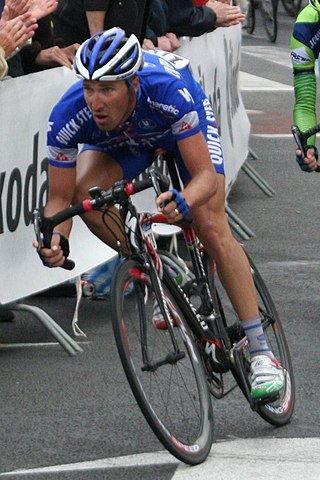Related Research Articles
The decibel is a relative unit of measurement equal to one tenth of a bel (B). It expresses the ratio of two values of a power or root-power quantity on a logarithmic scale. Two signals whose levels differ by one decibel have a power ratio of 101/10 or root-power ratio of 101⁄20.
In physics, power is the amount of energy transferred or converted per unit time. In the International System of Units, the unit of power is the watt, equal to one joule per second. In older works, power is sometimes called activity. Power is a scalar quantity.
The amplitude of a periodic variable is a measure of its change in a single period. The amplitude of a non-periodic signal is its magnitude compared with a reference value. There are various definitions of amplitude, which are all functions of the magnitude of the differences between the variable's extreme values. In older texts, the phase of a periodic function is sometimes called the amplitude.

Physical fitness is a state of health and well-being and, more specifically, the ability to perform aspects of sports, occupations and daily activities. Physical fitness is generally achieved through proper nutrition, moderate-vigorous physical exercise, and sufficient rest along with a formal recovery plan.

A mass spectrum is a histogram plot of intensity vs. mass-to-charge ratio (m/z) in a chemical sample, usually acquired using an instrument called a mass spectrometer. Not all mass spectra of a given substance are the same; for example, some mass spectrometers break the analyte molecules into fragments; others observe the intact molecular masses with little fragmentation. A mass spectrum can represent many different types of information based on the type of mass spectrometer and the specific experiment applied. Common fragmentation processes for organic molecules are the McLafferty rearrangement and alpha cleavage. Straight chain alkanes and alkyl groups produce a typical series of peaks: 29 (CH3CH2+), 43 (CH3CH2CH2+), 57 (CH3CH2CH2CH2+), 71 (CH3CH2CH2CH2CH2+) etc.
Indoor cycling, often called spinning, is a form of exercise with classes focusing on endurance, strength, intervals, high intensity and recovery, and involves using a special stationary exercise bicycle with a weighted flywheel in a classroom setting. When people took cycling indoors in the late 19th century, whether for reasons of weather or convenience, technology created faster, more compact and efficient machines over time. The first iterations of the stationary bike ranged from the vertical Gymnasticon to regular bicycles on rollers.
Peak ground acceleration (PGA) is equal to the maximum ground acceleration that occurred during earthquake shaking at a location. PGA is equal to the amplitude of the largest absolute acceleration recorded on an accelerogram at a site during a particular earthquake. Earthquake shaking generally occurs in all three directions. Therefore, PGA is often split into the horizontal and vertical components. Horizontal PGAs are generally larger than those in the vertical direction but this is not always true, especially close to large earthquakes. PGA is an important parameter for earthquake engineering, The design basis earthquake ground motion (DBEGM) is often defined in terms of PGA.

A stationary bicycle is a device used as exercise equipment for indoor cycling. It includes a saddle, pedals, and some form of handlebars arranged as on a (stationary) bicycle.
V̇O2 max (also maximal oxygen consumption, maximal oxygen uptake or maximal aerobic capacity) is the maximum rate of oxygen consumption attainable during physical exertion. The name is derived from three abbreviations: "V̇" for volume (the dot over the V indicates "per unit of time" in Newton's notation), "O2" for oxygen, and "max" for maximum and usually normalized per kilogram of body mass. A similar measure is V̇O2 peak (peak oxygen consumption), which is the measurable value from a session of physical exercise, be it incremental or otherwise. It could match or underestimate the actual V̇O2 max. Confusion between the values in older and popular fitness literature is common. The capacity of the lung to exchange oxygen and carbon dioxide is constrained by the rate of blood oxygen transport to active tissue.

Exercise intensity refers to how much energy is expended when exercising. Perceived intensity varies with each person. It has been found that intensity has an effect on what fuel the body uses and what kind of adaptations the body makes after exercise. Intensity is the amount of physical power that the body uses when performing an activity. For example, exercise intensity defines how hard the body has to work to walk a mile in 20 minutes.

High-intensity interval training (HIIT) is a training protocol alternating short periods of intense or explosive anaerobic exercise with brief recovery periods until the point of exhaustion. HIIT involves exercises performed in repeated quick bursts at maximum or near maximal effort with periods of rest or low activity between bouts. The very high level of intensity, the interval duration, and number of bouts distinguish it from aerobic (cardiovascular) activity, because the body significantly recruits anaerobic energy systems. The method thereby relies on "the anaerobic energy releasing system almost maximally".

In endurance sports such as road cycling and long-distance running, hitting the wall or the bonk is a condition of sudden fatigue and loss of energy which is caused by the depletion of glycogen stores in the liver and muscles. Milder instances can be remedied by brief rest and the ingestion of food or drinks containing carbohydrates. Otherwise, it can remedied by attaining second wind by either resting for approximately 10 minutes or by slowing down considerably and increasing speed slowly over a period of 10 minutes. Ten minutes is approximately the time that it takes for free fatty acids to sufficiently produce ATP in response to increased demand.
Intensity may refer to:
Lactate inflection point (LIP) is the exercise intensity at which the blood concentration of lactate and/or lactic acid begins to increase rapidly. It is often expressed as 85% of maximum heart rate or 75% of maximum oxygen intake. When exercising at or below the lactate threshold, any lactate produced by the muscles is removed by the body without it building up.

A vertical jump or vertical leap is the act of jumping upwards into the air. It can be an exercise for building both endurance and strength, and is also a standard test for measuring athletic performance. It may also be referred to as a Sargent jump, named for Dudley Allen Sargent.
Relative intensity noise (RIN), describes the instability in the power level of a laser. The noise term is important to describe lasers used in fiber-optic communication and LIDAR remote sensing.
Continuous Trainingis a form of exercise that is performed at a continuous intensity throughout and doesn't involve any rest periods.Continous training typically involves aerobic activities such as running,biking,swimming,and rowing. rest intervals. Continuous training can be performed at low, moderate, or high exercise intensities, and is often contrasted with interval training, often called high-intensity interval training. Some training regimens, such as Fartlek, combine both continuous and interval approaches.
Nominal power is the nameplate capacity of photovoltaic (PV) devices, such as solar cells, modules and systems. It is determined by measuring the electric current and voltage in a circuit, while varying the resistance under precisely defined conditions. The nominal power is important for designing an installation in order to correctly dimension its cabling and converters.
The ergonometer test is an anaerobic exercise test, most often performed on a stationary bicycle, that measures peak anaerobic power and anaerobic capacity. The test, which can also be performed on an arm crank ergometer, consists of a set time pedalling at maximum speed against a given resistance. The prototype test based on the Cumming’s test was introduced in 1974, at the Wingate Institute and has undergone modifications as time has progressed. The Wingate test has also been used as a basis to design newer tests in the same vein, and others that use running as the exercise instead of cycling. Sprint interval testing such as is similar to the construction of the Wingate test has been shown to increase both aerobic and anaerobic performance.
Underwater cycling is stunt, usually done for charity, in which a rider wears scuba diving gear and rides a bicycle in an underwater course. The Underwater Bike Race is an annual charity fundraiser held in North Carolina.
References
- ↑ Di Donato, Danielle; West, Daniel; Churchward-Venne, Tyler; Breen, Leigh; Baker, Steven; Phillips, Stuart (2014). "Influence of aerobic exercise intensity on myofibrillar and mitochondrial protein synthesis in young men during early and late postexercise recovery". American Journal of Physiology. Endocrinology and Metabolism. 306 (9): E1025–E1032. doi:10.1152/ajpendo.00487.2013. PMC 4010655 . PMID 24595306 . Retrieved 14 June 2015.